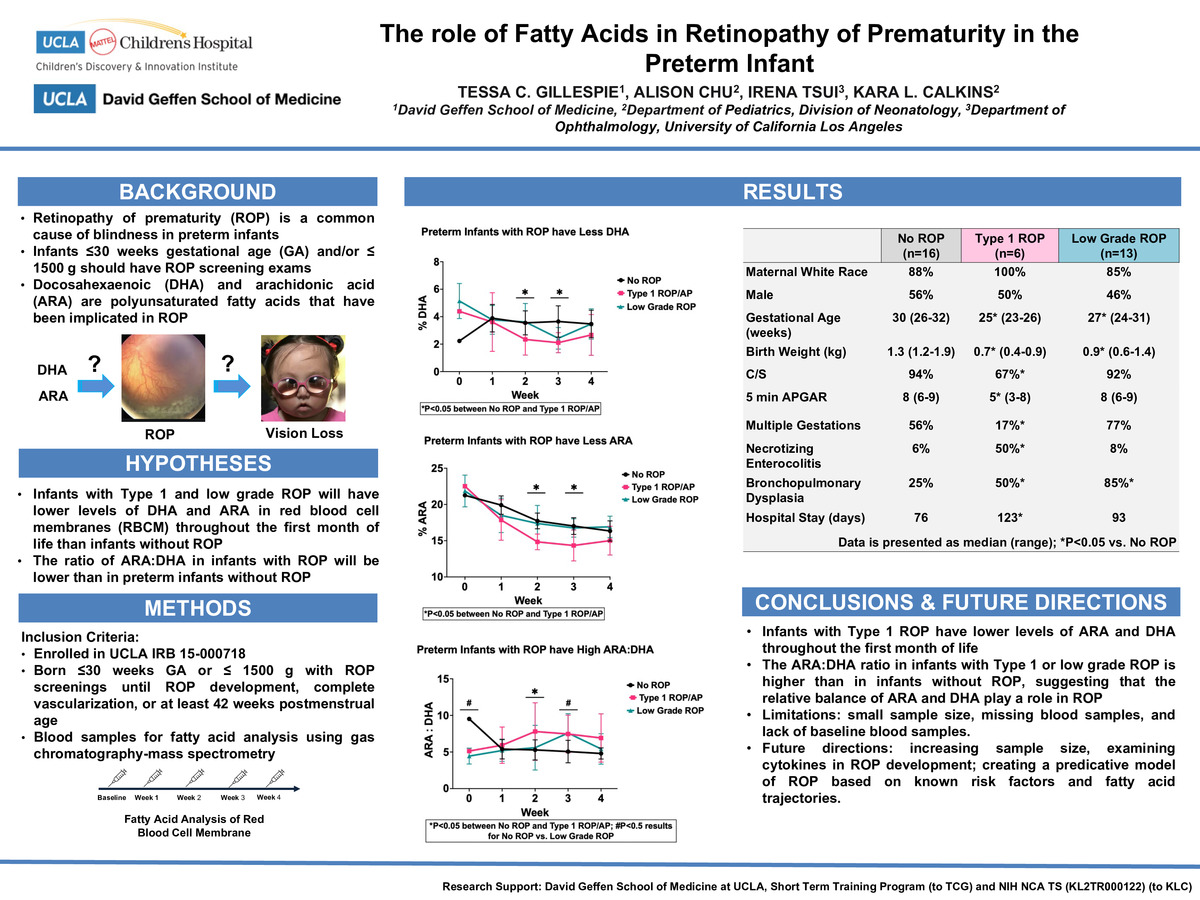-
Author
Tessa Gillespie -
PI
Kara L. Calkins
-
Co-Author
-
Title
The role of Fatty Acids in Retinopathy of Prematurity in the Preterm Infant
-
Program
STTP
-
Other Program (if not listed above)
-
Abstract
Introduction: Retinopathy of prematurity (ROP) is characterized by disrupted vascularization of the retina followed by pathologic neovascularization into the vitreous of the eye. ROP can lead to retinal detachment and permanent visual impairments. Very low birth weight infants (birth weight < 1.5 kg) are at high risk for ROP since retinal maturation begins in the second trimester and extends to the late third trimester. Research suggests that ROP development is impacted by polyunsaturated fatty acids (PUFAs), specifically docosahexaenoic acid (DHA) and arachidonic acid (ARA). DHA and ARA are preferentially transferred to the fetus during the third trimester. As a result, preterm infants quickly develop DHA and ARA deficiencies. The overarching aim of this research is to investigate the role of DHA and ARA in ROP by further characterizing the red blood cell membrane (RBCM) content of DHA and ARA and their trajectories in preterm infants who develop severe (Type 1) as well as less low grade ROP compared to preterm infants who do not develop ROP.
Methods: This is a secondary analysis of a subset of infants accrued to [UCLA IRB 15-000718]. Infants were eligible for this study is they were born ≤ 30 weeks gestational age or ≤ 1.5 kg, and they had ROP screenings until ROP development, complete vascularization, or at least 42 weeks postmenstrual age (n=35). Blood samples were collected at baseline and every week thereafter. Analysis of blood samples for DHA and ARA levels was performed using gas chromatography-mass spectrometry. ARA, DHA, and ARA:DHA levels from the Type 1 ROP and low grade ROP cohorts were compared against the no ROP group using unpaired T tests.
Results: Infants with Type 1 ROP had lower levels of ARA and DHA in the second and third week of life compared to patients without ROP (p<0.05 for all comparisons). The ARA:DHA ratio in infants with Type 1 ROP is higher than infants without ROP at the second week of life (p<0.05), and the ratio in infants with low grade ROP is higher at baseline and the third week of life (p<0.05).
Conclusions: Preliminary analysis demonstrates that preterm infants with either Type 1 or low grade ROP have lower levels of ARA and DHA throughout the first month of life whereas their ARA:DHA ratio is higher than in preterm infants without ROP. This suggests that ARA, DHA, and their relative balance are important in the development of ROP in neonates. This study is limited by the small sample size, missing blood samples, and use of RBCM PUFA levels as conduits for retinal PUFA levels. Future directions for this project include increasing the sample size, investigating the role of cytokines in ROP development, and creating a predictive model for ROP based on known risk factors and fatty acid trajectories.
-
PDF
-
Zoom
https://uclahs.zoom.us/j/91257006697?pwd=c0tzYm5CUVJYNHJVYTJTTTQwd1FDZz09

